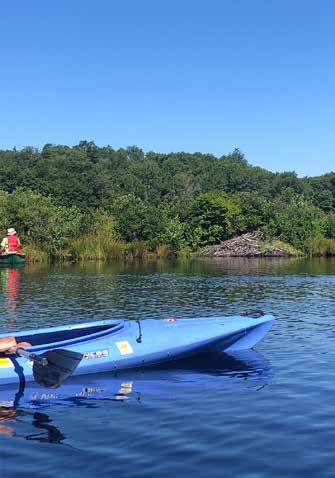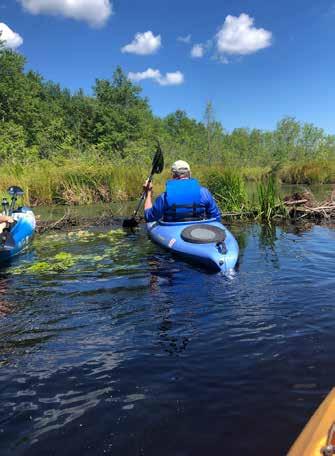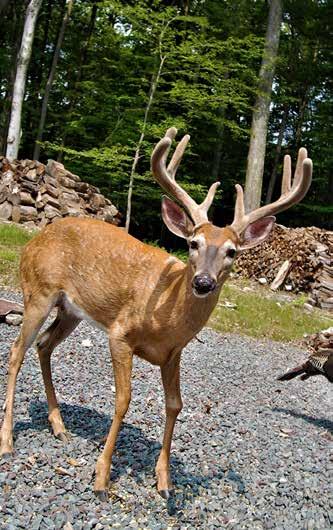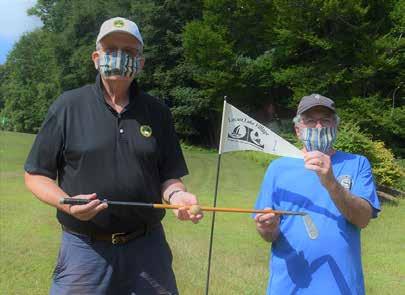
4 minute read
Snapping Turtles
There were three awesome sandcastles and some ferocious sea creatures. Ist Place went to Abel and Adam Wiener-Bellows for their castle, complete with an aqueduct, and a bench in the garden for lovers.
Other creators were Ari and Arielle, and the Lyons Family, who created the sea creatures and a castle to boot.
Advertisement



I don’t know if you have ever seen the snapping turtles that live in Locust Lake. This photo was taken over by the rocks on the north side of Locust Lake. It is not a good idea to get too close though and you never want to take one of these home! Snapping turtles can weigh up to 25 pounds and their shell can be as long as 18 inches. They live a long time; up to 50 years. When they are threatened, instead of pulling their head and legs into their shell-like other turtles, they instead go on the offensive, snapping and biting at the predator.
They don’t like to swim much; a lot of the time they reside on the bottom of the lake or river or on the rocks, partly submerged in the water, and wait for a tasty morsel to swim by. When its prey swims by, the turtle grabs it and use its jaws to snap it. They like to eat fish, frogs, and ducks and geese. Due to its wide throat, it can swallow whole fish and baby ducks and geese. They are omnivores, so they also eat plants and sometimes even leeches and water snakes. After mating, the female builds its nest usually between October and April. They are often seen here in May and June, when they leave the water to lay their eggs on the land. The turtle digs in the sand or mud to make a small hole and then lays its eggs inside the hole. A female snapping turtle can lay between 20 and 80 eggs at one time. The baby turtles emerge from the eggs about three months after they are laid.
Of the 13 turtle species native to Pennsylvania, only the snapping turtle has a season (July 1-Oct. 31), a daily limit (15) and a possession limit (30). They normally swim away from humans when in the water, but when they are laying their eggs, they are more aggressive. While snapping turtles may not be welcome at many lakes, they display an important role in the lake “clean-up crew” by scavenging dead and decaying organic debris and nuisance aquatic plants.
Dedication to Tom Dowd
On August 29, the Locust Lake Archery Club held a dedication ceremony for Tom Dowd, who passed away in July. Tom was a founding member of the Archery Club and was the current secretary. A plaque was placed in a tiny garden on the Club grounds and the current president of the Archery Cub, Bob Gettis, recounted his service to the club.

CONTINUED FROM PAGE 1



Fun Paddle at Brady’s Lake
mosquito larvae and even fish fry brush against small hairs on the bladders, the bladder snaps shut, trapping the prey.
At the far end of the lake, the inlet is more of a wetland with many creek channels. We continued through this wetland and found the two other goals of our trip, the Pitcher plant and the Sundew. Pitcher plants, made famous by the show Little Shop of Horrors, have deep cavities containing digestive juices. Flies and such, and even small animals such as salamanders, fall in or are guided deep into the plant, become trapped in the sticky substance and eventually are digested by the plant. (Eew!). The other plant we found was called Sundews. These plants trap their prey using sticky hairs on their leaves. We continued up the creek and clambered over two beaver dams, assisted by the guides. Eventually we met a large beaver dam, probably been there a decade more, with bushes and saplings growing out of it. This imposing barrier was the end of the trip.




Luckily, the day was beautiful, not too hot and perfect for the long paddle. It is easy to get on the Kettle Creek mailing list to be aware of other opportunities for group fun and education. Kettle Creek Environmental Education Center (in Stroudsburg) has hiking trails that are open, and a nature center now closed. It is funded by the Monroe County Conservation District.





